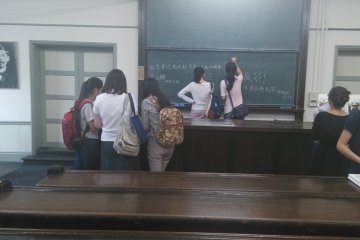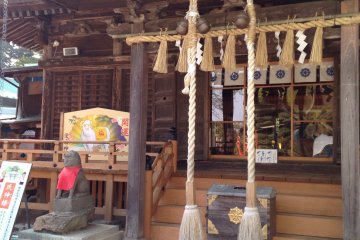One of the first things I saw when I arrived at Sendai Station was a giant stained glass window representing the most famous things from Sendai. In bright colors, there were Tanabata decorations, a view of Matsushima and, in the top corner, a small figure riding a horse and wearing a distinctive helmet – Date Masamune.
If you go to all the usual tourist spots in Sendai, it's almost impossible not to learn about Sendai's founder. Also known as the One-eyed Dragon, his influence in the Tohoku region allowed Sendai to become the city it is today. With this in mind, I went to pay my respects at his final resting place, Zuihoden.
Although you can easily reach Zuihoden using the Loople bus (a day pass also gives a discount on the entry price), the site itself isn't the most accessible. There are steep inclines without ramps, making it difficult for anyone with limited mobility.
All of the signs on the site include English, although it doesn't provide as much information as in Japanese. The leaflet I was given was very informative and would be sufficient to understand the key features of the site if no other means was available. If you can, though, I would recommend the free guide service which is available in English, but dependent on which volunteers are there on a given day. Or you could specially request a guide in advance through Sendai's GOZAIN interpreter service for Zuihoden or anywhere in the city for that matter.
Like many historical sites, Zuihoden is very atmospheric. It can be appreciated in all seasons, with the extra beauty of blossoms in spring, red leaves in fall and snow in winter. The intricate architecture, in the Momoyama style, is really something to behold, with its detail and bright colors. The current Zuihoden is a replica, but you wonder how they managed to achieve such striking hues when it was first built. There is also a lot of meaning to the design, with pairs of animals symbolizing the beginning and end of life.
In the onsite museum included with admission, you can discover more about the archeological digs that took place before the rebuilding, and see the small parts that were left after the original was burnt down. There is also a half-size copy of the wooden statue of Date Masamune that is in the Zuihoden structure. The original is only seen rarely, when the doors are opened, for example the first night of Tanabata. There is a video showing some of the archeological work and the re-burial of the first three feudal lords of Sendai-han, but the commentary is all in Japanese.
The resting places of the two subsequent feudal lords of Sendai, Masamune's descendents, are very similar to his, although a little less ornate. The children's graveyard is a stark remainder of the survival rates of childhood in the past, even among wealthier families.
Overall, it is a very peaceful place, surrounded by nature. Most of it is outside, so take the weather into consideration when you visit. Take your time and maybe take a small bow towards the resting place of the man who made Sendai.












